
Office: 305 Coulter Hall
Phone: 662-915-1814
Email: cizdziel AT olemiss.edu
Educational and Professional Background
BS, State University of New York at Buffalo, 1991
Ph.D., University of Nevada Reno, 1998
National Research Council Postdoctoral Fellow, US EPA, National Exposure Research Laboratory, 1998-2000
Senior Chemist, Harry Reid Center for Environmental Studies, University of Nevada Las Vegas, 2000-2005
Associate Research Professor, UNLV, 2005-2008
Assistant Professor, University of Mississippi, 2008-present
Research Interests:
Analytical chemistry, environmental chemistry, forensic chemistry, biogeochemical cycling of mercury, environmental radioactivity, environmental monitoring and fingerprinting, analytical method development.
Research Summary
My research interests are in the area of analytical, environmental, and forensic chemistry. I am particularly interested in environmental monitoring and fingerprinting using isotope based methods. What counts in science is novelty. To that end, we enjoy developing new measurement techniques or applying standard techniques in novel ways. Listed below are some examples of the type of research that you may pursue if you were to join my group. I would welcome the opportunity to discuss these and other research possibilities with you as you decide whether to pursue graduate education in chemistry at Ole Miss.
Trace Elemental Analysis. I am interested in studying the behavior of trace elements (both stable and radioactive) in the environment. This sometimes involves developing novel analytical methods for measurement of the element or forms of the element (speciation). One of the methods we employ involves direct elemental and isotopic analyses of environmental or biological samples using laser ablation inductively coupled plasma mass spectrometry (LA-ICP-MS). This allows us to map the elemental distribution in, for example, tree rings, thin sections of brain tissue, glass shards, paint chips, fish otiliths, leaves, etc. Current research projects in this area include in-situ elemental analysis of leaves, herbal supplements, and biological shells, and the analysis of human hair and animal fur for metals. Future work may include environmental fate and transformation of nanoparticles, and evaluating metal redistribution in soils and biological uptake resulting from invertebrate burrowing, among others.
Mercury. Mercury (Hg) has probably the most complex biogeochemical cycle among the elements. Because of its tendency to bioconcentrate in food chains in the form of methyl-Hg and cause detrimental human health and ecological effects, it continues to be a hot button issue and a priority pollutant. Indeed, Hg is responsible for the most fish consumption advisories in the nation due to elevated Hg levels in fish flesh. This includes reservoirs in northern Mississippi nearby our campus. Current research projects in this area include the distribution and cycling of Hg in the Yocona River Watershed and development of a combustion-CVAFS system for Hg analyses. Future research projects may include, addressing spatial and dry deposition data gaps in Hg cycling chemistry models, evaluating Hg release characteristics from compact fluorescent lamps, environmental forensic investigations of Hg using high precision isotope measurements, and using mosquitoes as bio-indicators methyl-Hg accumulation in food webs, among others.
From the above examples and the select publications listed below you can get a sense of the type of research my group conducts. The studies often include a combination of method development and field experiments that serve to provide much needed quality data to address current hype on an issue or to increase understanding of natural phenomena. My experience and expertise in environmental and analytical chemistry offers opportunities for students to apply chemical principles to understand environmental problems, the first crucial step in solving them.
Instrumentation. Our research laboratory is well-equipped for trace elemental and isotopic analysis. It includes a high resolution ICP-MS (Element-XR), a quadrupole-ICP-MS (X-Series 2), a laser ablation system (UP-213 New Wave), an ICP-OES (Perkin Elmer Optima 2100), a microwave digestion system (Milestone Ethos EZ), a cold vapor atomic fluorescence spectrometer (Tekran 2600), a direct mercury analyzer (DMA-80 Milestone), an automated MeHg analysis system, airborne mercury speciation equipment, and clean-room facilities. We also have access to a variety of other instruments commonly found in Chemistry Departments such as GC/MS, NMR, XRF, FT-IR, and IRMS.
ICP-MS Facility. We are fortunate to have a new state-of-the-art ICP-MS facility housed in the Department of Chemistry and Biochemistry. ICP-MS is a sensitive multi-element technique which provides a powerful analytical tool for trace elemental and isotope analysis. It is used in a wide-variety of environmental, biological, medical, forensic, geological and archaelogical studies. For more information, see the instrumentation section below and visit our website at: https://www.olemiss.edu/depts/chemistry/icp-ms/index.html
COURSES. Quantitative Analysis (CHEM 314); Introduction to Instrumental Analysis (CHEM 469); Advanced Instrumental Analysis (CHEM 512); Applied Spectroscopy (CHEM 563); Environmental Forensics (CHEM 615); Inductively Coupled Plasma Mass Spectrometry (CHEM 615)
Recent Publications
Bu K., Russ J., Cizdziel J. (2013) The source of iron-oxide pigments used in Pecos River style rock paints, Archeometry (in press; online first 16 Jan. 2013). DOI: 10.1111/arcm.12011
Davidson G.R., Rigby J.R., Pennington D., Cizdziel J. (2013) “Aqueous chemistry of sand-boil discharge used to trace variable pathways of seepage beneath levees during the 2011 Mississippi River flood” Applied Geochemistry Applied Geochemistry 28: 62-68.
Bu K., Reidy L. and Cizdziel J. (2013) “Analysis of Herbal Supplements for Selected Dietary Minerals and Trace Elements by Laser Ablation- and Solution-Based ICPMS”, Microchemical Journal: 106: 244-249.
Duke S., Reddy K, Bu K., and Cizdziel J. (2012) “Effects of Glyphosate on the Mineral Content of Glyphosate-Resistant Soybeans (Glycine max)”, J. Agric. Food Chem., 60 (27), pp 6764–6771.
K. Drace, A. Kiefer, M. Veiga, M. Williams, B. Ascari, K. Knapper, K. Logan, V. Breslin, A. Skidmore, D. Bolt, G. Geist, Lorlyn Reidy, Cizdziel, J, “Mercury-free, small-scale artisanal gold mining in Mozambique: Utilization of magnets to isolate gold at clean tech mine”, J. of Cleaner Production, 29 March 2012.
Russ J., Bu K., Hamrick J., Cizdziel J. (2012) “Laser Ablation-Inductively Coupled Plasma-Mass Spectrometry Analysis of Lower Pecos Rock Paints and Possible Pigment Sources” in Collaborative Endeavors in the Chemical Analysis of Art and Cultural Heritage Materials, ACS Symposium Series, Vol. 1103, Ch 5, pp 91–121.
Cizdziel J., Bu X., Nowinski P. (2011) “Determination of elements in situ in green leaves by laser ablation ICP-MS using pressed reference materials for calibration”, Analytical Methods, DOI: 10.1039/c1ay05577a.
Nowinski P., Hodge V., Cizdziel J., Lindley K. (2011) “Rock varnish: a passive forensic tool for monitoring recent air pollution and source identification”, Nuclear Technology, 175:351-359.
Cizdziel J., Jiang Y. (2011) “Concentrations of Gaseous Elemental Mercury in Ambient Air within an Academic Chemistry Building”, Bull. Environmental Contamination and Toxicology, 86:419–422.
Cizdziel, J. (2011) “Mercury in Environmental and Biological Samples Using Online Combustion with Sequential Atomic Absorption and Fluorescence Measurements: A Direct Comparison of Two Fundamental Techniques in Spectrometry”, Journal of Chemical Education, Vol. 88, 2:209-215.
Gamage S.V., Hodge V.F., Cizdziel J., Lindley K. (2010) “Determination of vanadium (IV) and (V) in southern Nevada groundwater by ion chromatography-inductively coupled plasma mass spectrometry” The Open Chemical and Biological Methods Journal, 3:17-24.
Cizdziel J., Chen W.Y., (2010) “GC/MS for Combustion and Pyrolysis Research”, Handbook of Combustion, Vol. 2, Combustion Diagnostics and Pollutants, Eds. M. Lackner, F. Winter, A.K. Agarwal, Wiley-VCH.
Nowinski P., Hodge V., Lindley K., Cizdziel J. (2010) “Elemental Analysis of Desert Varnish Samples in the Vicinity of Coal- Fired Power Plants and the Nevada Test Site Using Laser Ablation ICPMS”, The Open Chemical and Biomedical Methods Journal, 3: 153-168.
Cizdziel J., Brown G., Tolbert C. (2010) “Direct analysis of environmental and biological samples for total mercury with comparison of sequential atomic absorption and fluorescence measurements from a single combustion event”, Spectrochemica Acta Part B, 65: 186-172.
Cizdziel J., Guo C., Yu Z., Steinberg S., Johannesson, K. (2008) “Chemical and Colloidal Analyses of Natural Seep Water Collected from the Exploratory Studies Facility inside Yucca Mountain, USA”, Environmental Geochemistry and Health, 30:31-44.
Cizdziel J., Ketterer M.E, Farmer D., Faller S., Hodge V. (2008) “239Pu-240Pu-241Pu fingerprinting of plutonium in western US soils using ICPMS: solution and laser ablation measurements”, Special Issue: Stable Isotopes in Analytical Chemistry, Analytical and Bioanalytical Chemistry, 390:521-530.
James Cizdziel, Wei Y., Stetzenbach K., Hodge V., Cline J., Howley R., Phillips F. (2008) “Recent Measurements of Chlorine-36 in Yucca Mountain Rock, Soil, and Seepage” Journal of Radioanalytical and Nuclear Chemistry, 275: 133-144.
Panta Y., Qian S., Cizdziel J., Cross C. (2008) “Mercury content of whole cigarettes, cigars and chewing tobacco packets by pyrolysis atomic absorption spectrometry with gold amalgamation” Journal of Analytical and Applied Pyrolysis, 83:7-11.
Pollard J., Cizdziel J., Stave K., Reid M. (2007) “Selenium Concentrations in Water and Plant Tissues of a Newly Formed Arid Wetland in Las Vegas, Nevada”. Journal of Environmental Monitoring and Assessment, 135:447-457.
Cizdziel J. (2007) “Determination of lead in blood by laser ablation ICP-TOF-MS analysis of blood spotted and dried on filter paper: a feasibility study”, Analytical and Bioanalytical Chemistry, 388:603-611
Kimura H, Azmy K, Yamamuro M, Zhi-Wen J, Cizdziel J. (2005) “Integrated stratigraphy of the upper Neoproterozoic succession in Yunnan Province of South China: re-evaluation of global correlation and carbon cycle”, Precambrian Research 138:1-36.
Cizdziel J., Farmer D., Hodge V., Lindley K., Stetzenbach K. (2005) “234U/238U isotope ratios in springs and groundwater from southern Nevada: a comparison of alpha counting and magnetic sector ICP-MS”, Science of the Total Environment 350:248-260.
Cizdziel J., Zhou, X. (2005) “Sources and concentrations of Hg and Se in compartments within the Las Vegas Wash during a period of rapid change” Environ Monitoring & Assess 107:81-99.
Gremillion P., Cizdziel J. (2005) “Caudal fin mercury as a predictor of fish-muscle mercury”, Environ Chem. 2:96-99.

 orcid.org/0000-0001-6942-5451
orcid.org/0000-0001-6942-5451




